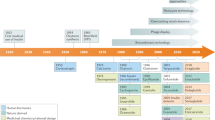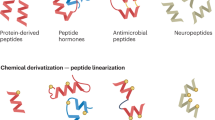Summary
After many years of stagnation, peptide therapeutics once again became the focus of innovative drug development efforts backed up by venture funds and biotechnology companies. Designer peptide drugs overcome the unattractive pharmacological properties of native peptides and protein fragments and frequently feature nonnatural amino acid or backbone replacements, cyclic or multimeric structures, or peptidic or nonpeptidic delivery modules. With their high specificity and low toxicity profile, biologicals offer viable alternatives to small molecule therapeutics. The development of peptide drugs requires specific considerations of this family of biopolymers. Historically, peptide vaccines to viral infections and antibacterial peptides led the way in clinical development, but recently many other diseases have been targeted, including the big sellers AIDS, cancer, and Alzheimer’s disease. This book gives practical advice to the most important steps in peptide-based drug development such as isolation, purification, characterization, interaction with targets, structural analysis, stability studies, assessment of biodistribution and pharmacological parameters, sequence modifications, and high throughput screening. This brief overview provides historical background for each of the listed techniques and diseases.
Access this chapter
Tax calculation will be finalised at checkout
Purchases are for personal use only
Similar content being viewed by others
References
Loffet, A. (2002) Peptides as drugs: Is there a market? J. Pept. Sci. 8, 1–7.
Ryser, H.J., and Fluckiger, R. (2005) Progress in targeting HIV-1 entry. Drug Discov. Today 10, 1085–1094.
Kazmierski, W.M., Kenakin, T.P., and Gudmundsson, K.S. (2006) Peptide, peptidomimetic and small molecule drug discovery targeting HIV-1 host-cell attachment and entry through gp120, gp41, CCR5 and CXCR4. Chem. Biol. Drug Des. 67, 13–26.
Mack, M., Luckow, B., Nelson, P.J., et al. (1998) Aminooxypentane-RANTES induces CCR5 internalization but inhibits recycling: a novel inhibitory mechanism of HIV infectivity. J. Exp. Med. 187, 1215–1224.
Hartley, O., Gaertner, H., Wilken, J., et al. (2004) Medicinal chemistry applied to a synthetic protein: Development of highly potent HIV entry inhibitors. Proc. Natl. Acad. Sci. USA 101, 16460–16465.
Powell, M.F., Stewart, T., Otvos, L., Jr., et al. (1993) Peptide stability in drug development. II. Effect of single amino acid substitution and glycosylation on peptide reactivity in human serum. Pharmacol. Res. 10, 1268–1273.
Polt, R., Porreca, F., Szabo, L Z., et al. (1994). Glycopeptide enkephalin analogues produce analgesia in mice; evidence for penetration of the blood-brain barrier. Proc. Natl. Acad. Sci. USA 91, 7114–7118.
Egleton, R.D., Mitchell, S.A., Huber, J.D., et al. (2000) Improved bioavailability to the brain of glycosylated Met-enkephalin analogs. Brain Res. 881, 37–46.
Otvos, L., Jr., Cudic, M., Chua, B.Y., Deliyannis, G., and Jackson, D.C. (2004) An insect antibacterial peptide-based drug delivery system. Mol. Pharmaceut. 1, 220–232.
Josserand, V., Pelerin, H., de Bruin, B., et al. (2006) Evaluation of drug penetration into the brain: a double study by in vivo imaging with positron emission tomography and using an in vitro model of the human blood-brain barrier. J. Pharmacol. Exp. Ther. 316, 79–86.
Werle, M. (2006) Innovations in oral peptide delivery. Future Drug Deliver.39–40.
Brogden, K.A. (2005) Antimicrobial peptides: pore formers or metabolic inhibitors in bacteria? Nat. Rev. Microbiol. 3, 238–250.
Zasloff, M. (2002) Antimicrobial peptides of multicellular organisms. Nature 415, 389–395.
Cudic, M., Lockatell, C.V., Johnson, D.E., and Otvos, L., Jr. (2003) In vitro and in vivo activity of antibacterial peptide analogs against uropathogens. Peptides 24, 807–820.
Otvos, L., Jr. (2005) Antibacterial peptides and proteins with multiple cellular targets. J. Pept. Sci. 11, 697–706.
Bray, B.L. (2003) Large-scale manufacture of peptide therapeutics by chemical synthesis. Nat. Rev. Drug Discovery 2, 587–593.
Garber, K. (2005) Peptide leads new class of chronic pain drugs. Nat. Biotechnol. 23, 399.
Meloen, R., Timmerman, P., and Langedijk, H. (2004) Bioactive peptides based on diversity libraries, supramolecular chemistry and rational design; A class of peptide drugs. Introduction. Mol. Diversity 8, 57–59.
Muderspach, L., Wilczynski, S., Roman, L., et al. (2000) A phase I trial of a human papillomavirus (HPV) peptide vaccine for women with high-grade cervical and vulvar intraepithelial neoplasia who are HPV 16 positive. Clin. Cancer Res. 6, 3406–3416.
Agdeppa, E.D. (2004) Rational design for peptide drugs. J. Nucl. Med. 47, 22 N–24 N.
Backer, M.V., Levashova, Z., Patel, V., et al. (2007) Molecular imaging of VEGF receptors in angiogenic vasculature with single-chain VEGF-based probes. Nat. Med. 13, 504–509.
Arai, H., Lee, V.M.-Y., Otvos, L., Jr., et al. (1990) Defined neurofilament, tau and beta-amyloid precursor protein epitopes distinguish Alzheimer from non-Alzheimer senile plaques. Proc. Natl. Acad. Sci. USA 87, 2249–2253.
Hoffmann, R., Lee, V.M.Y., Leight, S., Varga, I., and Otvos, L., Jr. (1997) Unique Alzheimer’s disease paired helical filament specific epitopes involve double phosphorylation at specific sites. Biochemistry 36, 8114–8124.
Adessi, C., Frossard, M-J., Boissard, C., et al. (2003). Pharmacological profiles of peptide drug candidates for the treatment of Alzheimer’s disease. J. Biol. Chem. 278, 13905–13991.
Kotha, S., and Lahiri, K. (2005) Post-treatment assembly modifications by chemical methods. Curr. Med. Chem. 12, 849–875.
Sehgal, A. (2002) Recent development in peptide-based cancer therapeutics. Curr. Opin. Drug Discov. Devel. 5, 245–250.
Borghouts, C., Kunz, C., and Groner, B. (2005) Current strategies for the development of peptide-based anti-cancer therapeutics. J. Pept. Sci. 11, 713–726.
Bruns, C., Lewis, I., Briner, U., Meno-Tetang, G., and Weckbecker, G. (2002) SOM230: a novel somatostatin petidomimetic with broad somatotropin release inhibiting factor (SRIF) receptor binding and a unique antisecretory profile. Eur. J. Endocrin. 146, 707–716.
Fedele, M., DeMartino, I., Pivonello, R., et al. (2007) SOM230, a new somatostatin analogue, is highly effective in the therapy of growth hormone/prolactin-secreting pituitary adenomas. Clin. Cancer Res. 13, 2738–2744.
Phan, J., Shi, Z-D., Burke, T.R., Jr., and Waugh, D.S. (2005) Crsytal structures of a high-affinity macrocyclic peptide mimetic complex with the Grb2 SH2 domain. J. Mol. Biol. 353, 104–115.
O, I., Otvos, L., Jr., Kieber-Emmons, T., and Blaszczyk-Thurin, M. (2002) Role of SA-Lea and E-selectin in metastasis assessed with peptide antagonist. Peptides 23, 999–1010.
Author information
Authors and Affiliations
Editor information
Editors and Affiliations
Rights and permissions
Copyright information
© 2008 Humana Press a part of Springer Science+Business Media, LLC
About this protocol
Cite this protocol
Otvos, L. (2008). Peptide-Based Drug Design: Here and Now. In: Otvos, L. (eds) Peptide-Based Drug Design. Methods In Molecular Biology™, vol 494. Humana Press. https://doi.org/10.1007/978-1-59745-419-3_1
Download citation
DOI: https://doi.org/10.1007/978-1-59745-419-3_1
Publisher Name: Humana Press
Print ISBN: 978-1-58829-990-1
Online ISBN: 978-1-59745-419-3
eBook Packages: Springer Protocols




